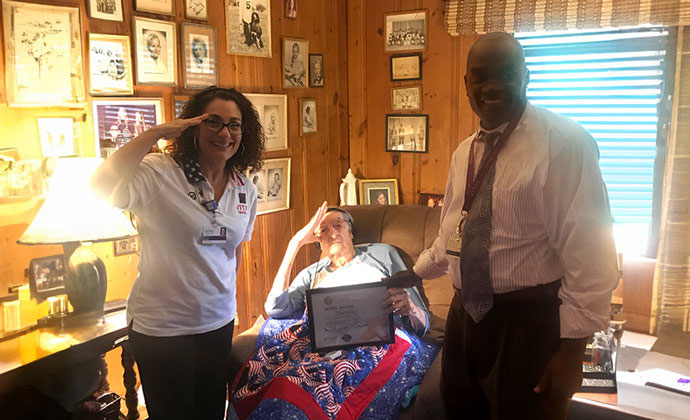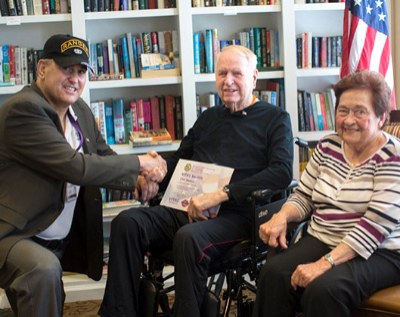Hospice Volunteers Elevate the Patient and Caregiver Experience

By Patty Husted, Executive Vice President, Patient and Family Supportive Services, VITAS Healthcare
Hospice care is a purposeful choice to enhance the quality of life for patients with serious illness and their caregivers. Clinical excellence is one aspect of quality hospice care. Supportive services, such as volunteer assistance, are another. These helpful individuals uplift patients nearing the end of life, provide relief, and run errands for their caregivers.
Hospice volunteers play a crucial role in enhancing the care experience for patients and their families. Their dedication and compassion contribute significantly to the well-being of those receiving end-of-life care. Volunteers provide support simply by being present, listening, and offering comfort during this time of need.
Holding a patient’s hand or offering a kind word can bring immense solace. Some volunteers assist with simple homemaking tasks, such as light housekeeping or getting necessary items, to alleviate some of the caregiver’s burdens and ensure the patient’s environment remains comfortable. Volunteers can also assist with feeding, which eases the workload for caregivers.
Volunteers are so vital to the end-of-life care experience that the Medicare Hospice Benefit requires that volunteer hours equal at least five percent of the hospice provider’s total patient care hours. Yet, increased volunteer hours may be even more impactful, whether volunteers serve in patients’ homes, senior living communities, or inpatient units. In a cross-sectional study, researchers found, “hospice programs with higher use of volunteers per patient day were associated with bereaved family member reports that the hospice program quality of care was excellent.”1
Integrating this supportive care with the clinical and spiritual aspects of hospice services is shown to increase the satisfaction of both patients and caregivers.
Assistance for Caregivers and Patients: Volunteers Support the Care Experience
According to the family members surveyed, “one of the most important types of support hospice palliative care volunteers provide is allowing them to take a much-needed break.”2 By offering relief visits, volunteers give caregivers the opportunity to rest, attend to personal matters, or recharge, knowing their loved one is in good hands.
Away from the bedside, volunteer sewers create meaningful legacy gifts by assembling articles of loved ones' clothing into keepsakes. These crafted items provide comfort and solace to grieving families. Volunteer sewers invest their time, creativity, and care into each piece, understanding the profound impact it will have on the bereaved.
“VITAS specialty volunteers include sewers who create Memory Bears or Memory Pillows for loved ones and caregivers,” said EVP Patient & Family Supportive Services Patty Husted. “Volunteers also craft fidget aprons and squares for our dementia patients. These tactile toys help keep them calm.”
While VITAS does not count these crafting hours toward the 5% of volunteer hours mandated for hospice providers by the Medicare Hospice Benefit, their significance as a legacy to caregivers is everlasting. “My parents have been gone for 13 years, and I still have the Memory Bears placed prominently in my home,” said Patty.
In 2023, more than 3,100 VITAS volunteers spent 229,132 hours caring for almost 5,000 VITAS patients. VITAS volunteers made 7,380 Memory Bears, pillows, and quilts.

Donating their time and talents, volunteers serve in many capacities, including:
- Life Bio™ volunteers listen to patient stories to create a legacy booklet of the patient’s life.
- Musical Memories volunteers play music reminiscent of an earlier time in the patient’s life, bringing up memories to share. Sometimes dementia patients will start singing to a familiar tune.
- Remote volunteers assist by picking up and then delivering supplies to the patient’s home.
- Haircare volunteers pamper patients by cutting and styling hair.
- VITAS Individualized Pampering (VIP) program volunteers may provide fingernail painting, hand care, arts and crafts, or interactive activities like music or games. A questionnaire identifies which pampering activities a patient would most enjoy.
- Bereavement Telephone Assurance Program (BTAP) callers check in on the primary caregivers after the patient’s death to provide a listening ear and condolences. Bereavement volunteers also schedule in-person visits.
“As a volunteer, I’ve offered services including companionship, holistic care (therapeutic massage, healing touch, breathing meditation, chair yoga, active listening), and spiritual care,” says VITAS Volunteer Aruni Marapane. “Some families have contacted me, saying the end-of-life experience they went through with their loved one was positive and sacred because of my participation. It is an honor and indeed a privilege.”
Special Acts of Service: 11th Hour and Veteran Volunteers
Individuals who feel comfortable sitting with a patient as they are actively dying are called “11th Hour” volunteers. They stay with patients so they do not die alone.
“Sometimes veterans in uniform will sit vigil at the bedside to ensure that if there's no family or if family members can't be there, they are present for their fellow serviceperson,” said Patty. Several VITAS programs also work with veterans to arrange a bedside veterans salute.

This 11th Hour service extends beyond veterans as well. “Family members and caregivers thank me for being there to ease their worries,” says 11th Hour Volunteer Karen Lesniak. “One patient moved, and her hand ended up in mine. I thought it was accidental and started to take my hand away, but then I felt a grasp. It was very moving. Her family was out of state and rushed home to see my compassion shared with their mother. They were grateful she was not alone.”
Often, what drives these volunteers is personal experiences that invite empathy and service. “All of the losses of my closest loved ones have been sudden, shocking, abrupt, and unexpected,” says Karen. “I felt my time and presence was a beautiful way to help provide a break for families, and especially for patients who have no family around.”
Lightening the Load for Caregivers
Caregivers shoulder an incredible responsibility as they assume everyday care for their loved one with advanced cancer, heart disease, COPD, or other serious illness. A study in The Journal of Pain and Symptom Management states, “Around two million family caregivers assist with end-of-life symptom management annually, of whom 78% report difficulty.”3
Caregiving for those with Alzheimer’s or other dementia can be even more taxing. “The amount of time required for caregiving increases as dementia progresses; one study showed that people with dementia required 151 hours of caregiving per month at the outset of dementia, and this increased to 283 hours per month eight years later. This is an increase from approximately five hours a day to nine hours a day.”4
VITAS interdisciplinary teams support patients and their caregivers with 24/7 access to clinical care, including psychosocial and spiritual services. Having a team to lean on eases the pressure on caregivers and helps them navigate the unknowns during the end-of-life process.
“I think the hardest thing to hear from family members is, ‘I wish I knew of you sooner,’” says Patty. “People are scared, they're not sure what's going to happen, and it's the unknown that troubles them.”
When a parent, spouse, child, friend, or other loved one enters the end-of-life process, the emotional and physical rigor involved can be overwhelming. Hospice comes in to provide clinical help, supportive services, and team assistance to improve the experience for both patients and caregivers.
1 Block, et.al. (2010). Got Volunteers? Association of Hospice Use of Volunteers with Bereaved Family Members’ Overall Rating of the Quality of End-of-Life Care. Journal of Pain and Symptom Management. 39(3), 502-506.
2 Claxton-Oldfield, et.al. (2010). A Survey of Family Members’ Satisfaction With the Services Provided by Hospice Palliative Care Volunteers. American Journal of Hospice and Palliative Medicine. 27(8) 557-800.
3Mather, et. Al. (2022). Symptom Management Experience of End-of-Life Family Caregivers: A Population-Based Study. Journal of Pain and Symptom Management. 64(6):513-520.
4 2024 Alzheimer’s Disease Facts and Figures. Retrieved March 22, 2024 from Alzheimer's Association 2024 Alzheimer's Disease Facts and Figures.

The VITAS Advantage
By choosing VITAS for your hospice and palliative care needs, you, your patients or residents, and their families realize benefits that other providers cannot offer.
Learn More
